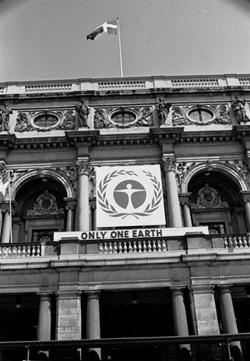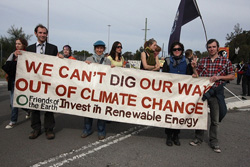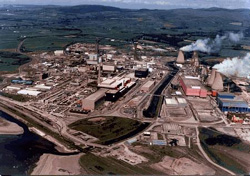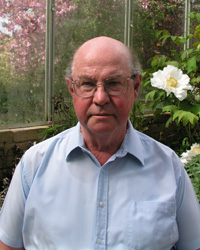Down With Fuel!
on
Down With Fuel!
Forty years ago this month, in December 1969, a midday edition of the Evening Standard changed my life. I was on the top deck of a London bus going around Hyde Park Corner. I picked up the discarded newspaper next to me and leafed idly through it. Suddenly my eye was caught by a one-column headline on the leader page. It said ‘Your Environment’. The article below the headline noted with approval that three poets, one of them Ted Hughes, had just published the first issue of a new magazine called Your Environment. I was fascinated. But I could not have imagined what was going to happen to me as a result.
 |
| The Swedish parliamentary building hosted the United Nations Conference on the Human Environment in June 1972 |
One of the topics was radioactive waste. That struck a chord. A decade earlier I had graduated in Canada as a nuclear physicist. That, I should say, was academic nuclear physics. At one time I could tell you all you wanted to know - more than you wanted to know - about the beta-ray spectrum of iridium-192. I knew nothing about nuclear engineering or nuclear power. In the late 1950s nuclear power had burst into the popular media as a wonder-technology that would transform the future with ‘electricity too cheap to meter’. I had paid little attention. Like many others my concern was not nuclear power but nuclear weapons. One project for my master’s thesis was an automated detector for airborne radioactivity. It picked up in Winnipeg the fallout from the last US atmospheric nuclear weapons explosion in Nevada, more than 2000km away. But I paid no attention to nuclear power until the late 1960s.
Nevertheless, I spoke the language of nuclear technology. When I got the brochure from Your Environment, I offered to write them the article they wanted, about radioactive waste. They agreed. In June 1970 the magazine published my first bylined piece, entitled ‘Odorless, Tasteless and Dangerous’. I even got a confidential note from the Atomic Energy Authority press officer, congratulating me on my accurate and balanced reporting. I didn’t know at the time that my relations with the Atomic Energy Authority were going to go rapidly downhill. The article, by the way, is now on my website archive Walt Patterson On Energy, www.waltpatterson.org. When I reread it not long ago I was stunned to see myself referring, in 1970, nearly forty years ago, to fossil-fuel power plants causing ‘disturbance of the carbon dioxide balance in the biosphere’. About some problems, we’ve known far too long and done far too little.
As it turned out, Ted Hughes and the other poets soon lost interest in Your Environment; and I wound up editing it. By 1973 it had been taken over by an East Ender who proved to be keener on printing posters and pornography, and the magazine folded. By that time, however, I had attended the United Nations Conference on the Human Environment in Stockholm in June 1972, the first global megaconference, helping a new international organization called Friends of the Earth produce an independent daily newspaper we called the Stockholm Conference Eco. The following month the charismatic director of the UK wing of Friends of the Earth, Graham Searle, invited me to join its staff, in a tiny office in Poland Street in Soho, at a salary of £1500 a year. I told my wife Cleone, a hard-working dentist. She said ‘It needs to be done, and you can do it. If you want to, I’ll back you’. And she did.
Energy campaigner
 |
| Friends of the Earth campaigners promote the use of renewable energy in the fight against climate change |
In Poland Street, as the ‘energy crisis’ unfolded, I found myself, rather to my surprise, becoming an ‘energy campaigner’. I have been one ever since. At the time, neither I nor anyone else knew what an ‘energy campaigner’ might be or do. We were making it up as we went along, under mounting pressure of circumstances. Only much later did I have time to think about this novel job description, ‘energy campaigner’. The invitation from UK-ISES (International Solar Energy Society, ed.) to speak to you this evening was perfectly timed. I realized that this evening would be for me a fortieth anniversary, remembering that discarded newspaper and ‘Your Environment’. I welcomed the opportunity to reflect on what I’ve been doing for most of my life.
Preparing the lecture for this evening has been for me something of a nostalgia trip, recalling people, places and events of the 1970s that went by too fast at the time. Working for FOE, caught up in controversies about North Sea oil and nuclear power, I realized that I’d better do some serious homework. When it came to ‘energy’ as an environmental issue I had a lot to learn, not only about the science and technology, but also about the economics, the finances, the planning and the policy. That was why, in 1974, I joined the newly-established UK section of the International Solar Energy Society, and how I first met David Hall, Mary Archer, George Porter, Brian Brinkworth, Bernard McNelis, June Morton and other solar-energy friends and colleagues. As well as solar energy I tried to learn about wind energy, wave energy, geothermal energy, cogeneration and cleaner ways to use coal. I also began to think about how and why we use all this energy. At the time, I could not have imagined how much I’d need to learn about energy. Now I can hardly believe how much we all need to learn, in a hurry, while we still can.
Derelict platform sites
Half a century ago it was so simple. Those responsible were expanding the high-voltage electricity network as fast as possible. People wanted the electricity; but as for the pylons, they declared, stoutly and literally, ‘Not In My Back Yard!’ That was the origin of NIMBY. They objected to the visual intrusion and the inconvenience, and insisted ‘Put it somewhere else!’ Sometimes they won the argument, more often not. But that was as far as it went.
Matters rapidly grew more complicated. Soon people began to object not only individually but in groups. Opposing proposals to dam wild rivers for hydroelectricity, for instance in California and Norway, opponents argued not just ‘Put it somewhere else!’ but ‘Don’t do it at all!’ They were no longer defending only individual turf but what they saw as a common interest under threat. Of course what they saw as a threat the project promoters saw as a necessity, essential for future electricity supply - and as a source of revenue. That conflict has intensified ever since.
The people objecting also changed. The original NIMBYs objected because they were directly and immediately affected, to their detriment, by the proposed development. Soon, however, people were objecting essentially on principle, not because they experienced any direct disadvantage but because they simply did not like what was happening, for one reason or another. In the 1960s and thereafter, that of course was true not only for environmental issues but right across society, in many parts of the world. The phenomenon of public protest is material not just for an evening but for a career. Tonight I want to focus on the particular subset we’ve come to call energy campaigning.
NIMBYs were not and are not energy campaigners, as I would use the expression. Even in the hectic winter of 1973-74, amid the first ‘energy crisis’, my colleagues and I in FOE recognized that to campaign effectively on any aspect of energy - or indeed on any environmental issue - simply not liking what was happening was not good enough. We had to understand clearly what was happening and why. Clearly somebody thought a particular proposal made sense. Somebody wanted it to happen. How good was their argument? What were the counter-arguments? Which case was stronger? Only if we could articulate a strong case against the proposal could we campaign effectively to oppose it. That applied to all FOE’s campaigns, against packaging waste, against killing whales, against importing endangered species and - for me as energy campaigner - against concrete oil production platforms in the Highlands, and against American nuclear plants, plutonium reprocessing and fast breeder reactors.
Everyone has long since forgotten, for example, how the Conservative government, backed by the oil companies and the construction companies, proposed to nationalize coastal sites in Scotland to build vast concrete platforms for North Sea oil. FOE joined local people and the National Trust for Scotland to oppose the plan to demolish the thirteen houses of Drumbuie, opposite the Isle of Skye. In my evidence to the Drumbuie inquiry I said that FOE analysis showed that if government plans went ahead, within five years we would have derelict platform sites all around Scotland. As it turned out, I was wrong. It was only three years. But we defenders of Drumbuie did win our case.
Packed house
That was another important feature of energy campaigning. We would only launch a campaign if we could make our case clear-cut and convincing. We did not waste effort on heroic futile gestures. When we launched a campaign we expected to win. Often enough we did; but not always, especially about the nuclear issues that dominated my years with FOE. Writing the piece on radioactive waste had awakened my curiosity. I plunged into an intensive study on nuclear matters. I quickly learned enough about nuclear power to become seriously skeptical about it. I already spoke the language well enough not to be dazzled by the prevailing impression that only experts could make decisions about nuclear technology. The whole idea of leaving public policy in a democratic society to be decided by ‘experts’ made me profoundly uneasy. The ‘experts’ declared that the only reason people were concerned about nuclear power was because they didn’t understand it. For my part, the more I learned about nuclear power the more concerned I became.
In that hectic autumn of 1973, the Central Electricity Generating Board, the CEGB, the government-owned monopoly operator of the power stations and transmission lines in England and Wales, revealed that it wanted to switch to American nuclear power stations instead of British designs. It soon declared, moreover, that it wanted to order, in the next ten years, 32 reactors larger than any yet operating anywhere in the world. The CEGB was then one of the most powerful and influential bodies in the UK. We at Friends of the Earth were not the only ones who thought the CEGB had lost its marbles.
Amory Lovins and I had already been tracking worrying safety issues about American reactors for well over a year. We held a press conference at FOE that drew a packed house - national press, broadcasters, trade press, the lot. It turned into a technical seminar lasting all afternoon. Soon everyone in the UK seemed to be caught up in the controversy. It raged until the summer of 1974, at which point the new Labour government turned the CEGB down flat. But other nuclear issues soon burst onto the environmental agenda, including the plan by British Nuclear Fuels for a new reprocessing plant at what was then called Windscale, now Sellafield.
To demystify nuclear power and make campaigning easier, I wrote a book about it, a Penguin book just called Nuclear Power, first published in 1976. The final edition came out in 1986, a week before they blew up Chernobyl. The book eventually sold about 130 000 copies in English, and appeared in five other languages. It’s now available as a free PDF download on my website archive, and is still downloaded more than 300 times a month. Even though it’s now nearly 25 years old, far too much of it is still relevant in the alleged ‘nuclear renaissance’ that nuclear promoters, politicians and media now proclaim. As my home page says, we have been here before.
 |
| The Sellafield Thermal Oxide Reprocessing Plant (THORP) |
Nuclear façade
After the Windscale debacle I left FOE, completely burned out. But I still felt like an energy campaigner, indeed more so, battle-hardened and with no illusions. Through the 1980s I continued to be caught up in nuclear controversies both in the UK and elsewhere. But I was also pursuing other energy issues, often advocating, not opposing. I’d long been convinced, for instance, that we could make better use of coal. In due course I wrote three management reports on advanced coal-use technology for the Financial Times. Although the reports were best-sellers, coal producers themselves proved to be utterly uninterested in how coal is used. All they want to do is dig it up and sell it. I abandoned the campaign on coal, especially once climate and carbon dioxide rocketed up the environmental agenda.
Twenty years ago last month to the day, on 9 November 1989, the Thatcher government gave up trying to sell the UK’s nuclear power stations. Investors in the City of London had threatened to boycott the privatization of UK electricity if the nuclear stations were part of the package. Mrs Thatcher and her colleagues, conceding defeat, withdrew the nuclear stations from the sale. I spent the day shuttling from one broadcast studio to another, commenting that liberalization had finally shattered the nuclear facade, to reveal the true, abysmal economics of nuclear power, so long hidden and denied. Late that evening, as we entered the ‘Newsnight’ studio at BBC TV Centre, I caught sight of a monitor. ‘Have they opened the Berlin wall?!?’ I asked, incredulous. ‘Why talk about UK nuclear power on a night like this?’ But we did. Only later did I notice the startling parallel of the two events on 9 November. A month ago I sent the Guardian, the FT and the Indy a letter pointing this out. None of them published it.
By 1990 I was bored with the sound of my own voice on nuclear power, tired of reiterating yet again the same arguments that had hardly changed for fifteen years. I was delighted to move on to more rewarding topics, especially electricity itself, suddenly exciting and controversial. In 1991, after nearly two decades as an energy campaigner and troublemaker, I was frankly dumbfounded to be invited to become a fellow of Chatham House. One of my first projects, drawing on my earlier interest in coal technology, was to report on the prospects for biomass power - electricity generation and cogeneration based on biomass fuel. Needless to say one of my first calls was to my old mate David Hall, whose work on biomass energy I had followed ever since we first crossed paths in 1974.
David, too, was an energy campaigner, exemplary in his use of data, an incisive analyst, and an indefatigable advocate for biomass energy, engaging, persuasive and compelling. I have to say, however, that one of my most vivid recollections of David at his most persuasive had nothing to do with biomass. It came in about 1993. He was teaching an undergraduate course on energy at the Campden Hill campus of King’s College London. On a number of occasions he had enlisted me as a visiting lecturer, to explain nuclear energy to his students. After 1990 I had resolved to extricate myself from nuclear entanglements, to allow me to clear the decks for my burgeoning interest in innovative electricity. I turned down speaking invitations, declined to comment to radio and television, and gradually struggled free of the nuclear morass. Then along came David, inviting me to give his latest students yet another lecture on nuclear power. I explained that I’d stopped following nuclear issues, and had no desire to be identified any longer as a nuclear specialist. In vain: in the nicest possible way, David inveigled me to come out of nuclear retirement for one last gig, long after I thought I’d escaped. The lecture I gave for David in 1993 was my last public appearance in a nuclear context for some thirteen years. Only in 2006 did Chatham House at last get me back onto its podium, to talk about ‘The Emperor’s Nuclear Clothes’. If you’re interested, the text is on my website. When writing this lecture I reread it. I’d forgotten how angry I was. That indeed is the reason I now decline all invitations to comment on this latest nuclear nonsense. I can’t keep my temper.
Infrastructure electricity
Let’s talk instead about electricity, and the exhilarating possibilities it now offers. This is what energy campaigning does to you. If you keep at it long enough, you find yourself developing a vision of what might be. Since I started working and campaigning on electricity, nearly two decades ago, I’ve gradually come to realize that innovative electricity holds the key to the long-term future of civilization, indeed the key to the future of our planet. If that sounds an extravagant claim, let me try to justify it, at least in outline. You’ll find a lot more detail on my website.
Governments have been telling us for decades that we have to reduce our use of energy. I am a physicist, and a pedant; and I’m telling you that governments are wrong, wrong, wrong. I know what energy really means, and so do you who work in solar energy. We can use as much energy as we want. That’s how the universe works. But we have to reduce our use of fuel. The distinction is not just pedantic. It is crucial. Using fuel is why we worry about what politicians call ‘energy security’, but ought to call ‘fuel security’. Using fuel is the main reason why we are upsetting the climate. That’s why electricity is the key to a sustainable energy future. Electricity will help us to reduce our use of fuel.
Fuel is a substance. You have to carry it to where you want to use it, often now over many thousands of kilometers. Electricity is not a substance. It is a process. If you have the right technology, the right infrastructure, you can generate electricity anywhere, in any quantity from minute to vast. In particular you can generate it close to where you want to use it, in a versatile variety of ways.
Human society uses two different kinds of electricity. One we generate using the stored energy in fuel, such as coal, natural gas or uranium. The other we generate using technology to convert natural ambient energy into electricity, including hydro, wind, photovoltaic, solar thermal, wave, tidal and geothermal. This electricity does not use fuel. Most people call it ‘renewable’, a term I dislike because it’s meaningless. I call this electricity ‘infrastructure electricity’. It is created and delivered by the function of physical assets, not by combustion or any other reaction. Once the assets are in place and functioning, whenever the natural ambient energy is available the infrastructure converts it into electricity, for us to use however we wish.
Do you see where this might lead? To me the corollary is obvious. Using fuel the way we do threatens the security of our energy services and the climate of the only planet we have. Of all the ways we use fuel, generating electricity is the easiest to change. To get better, more reliable, more universally available and sustainable electricity services, we should be campaigning to move as rapidly as possible away from fuel-based electricity to infrastructure electricity, for every feasible application, all over the world.
Economic fortunes
While preparing this presentation I’ve been mulling over possibilities for such a campaign. We could use a short, catchy slogan, suitable for banners, badges and buttons - ‘Down With Fuel!’ But the campaign itself would have to be much more subtle than that - coherent, comprehensive and of course long-term, and I do mean l o n g. Background material would have to explain how we use and produce electricity now, and how that might change, including technology, finances, institutions and politics. The campaign would map out a programme of feasible stages of change to electricity systems, over not just years but decades. The century-old model of remote large-scale central generating stations and long high-voltage lines should gradually evolve, incorporating much more decentralized small-scale generation and cogeneration close to users. Optimizing local systems with high-performance user-technology, especially buildings, will accelerate progress toward a low-fuel electric future, in the UK and around the world. You can find a tentative first draft of such a programme in my books Transforming Electricity and Keeping The Lights On. But it needs a lot more work.
The campaign would have to consider how to cope with those who now do very well out of traditional electricity, who have a long track record of stubborn and effective opposition to innovation. In particular it would have to challenge the dominance of those - not just companies but entire countries - whose economic fortunes now depend on selling fuel. The campaign would have to make the case for the advantages of innovative electricity, especially infrastructure electricity, to politicians, business, finance, academia, the media and the general public. It would have to argue, for instance, that traditional economics and accounting procedures misrepresent the values and benefits of infrastructure electricity, which are based on long-term investment rather than short-term commodity transactions. It would have to unpick the convoluted finances of fuels, with all the multifarious government support mechanisms and regulatory assumptions that distort what purport to be free markets, and make fuel-based electricity look cheaper than infrastructure electricity.
Over time, if we begin to get this right, as electricity systems move out of the nineteenth into the twenty-first century, we’ll find that electricity provides a steadily increasing proportion of the energy services that society desires; and that most of this electricity is infrastructure electricity.
At this point, however, I’m sure David Hall would gently but firmly intervene. That’s all very well, he would point out; but humans have used fuel ever since we learned to control fire. No matter how versatile, reliable and clean we make electricity, we are not going to stop using fuel. For some applications and some services, fuel will always be the right choice. To David, and to his friends and colleagues, I would respond by saying ‘Exactly. When we learned to control fire, the fuel we used was biomass. In the sustainable energy future, for the energy services best provided by fuel, we shall use, with scrupulous care, the once and future fuel we now call biomass.’
For me, over four decades, energy campaigning has come to this. I now seem to be campaigning to change the way the world works. I won’t be around to see whether this campaign succeeds. But I’m convinced that we can win it. Let’s go for it. Down With Fuel!
(c) Walt Patterson 2009
|
Who is Walt Patteson?
|


 Walt Patterson is Associate Fellow in the Energy, Environment and Development Programme at Chatham House in London, UK, and a Visiting Fellow at the University of Sussex. He is author of Keeping The Lights On: Towards Sustainable Electricity (Chatham House/Earthscan 2007, paperback 2009), his thirteenth book, and hundreds of other publications, on nuclear power, coal technology, renewable energy, energy systems, energy policy and electricity. His current project for Chatham House and the Sussex Energy Group is called ‘Managing Energy: for climate and security’. Walt Patterson On Energy,
Walt Patterson is Associate Fellow in the Energy, Environment and Development Programme at Chatham House in London, UK, and a Visiting Fellow at the University of Sussex. He is author of Keeping The Lights On: Towards Sustainable Electricity (Chatham House/Earthscan 2007, paperback 2009), his thirteenth book, and hundreds of other publications, on nuclear power, coal technology, renewable energy, energy systems, energy policy and electricity. His current project for Chatham House and the Sussex Energy Group is called ‘Managing Energy: for climate and security’. Walt Patterson On Energy,
Discussion (0 comments)